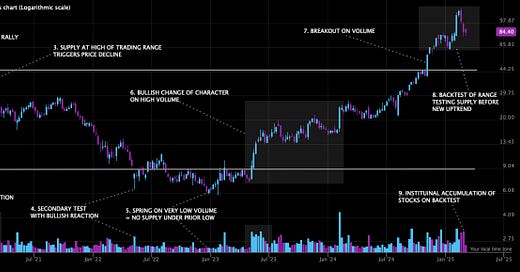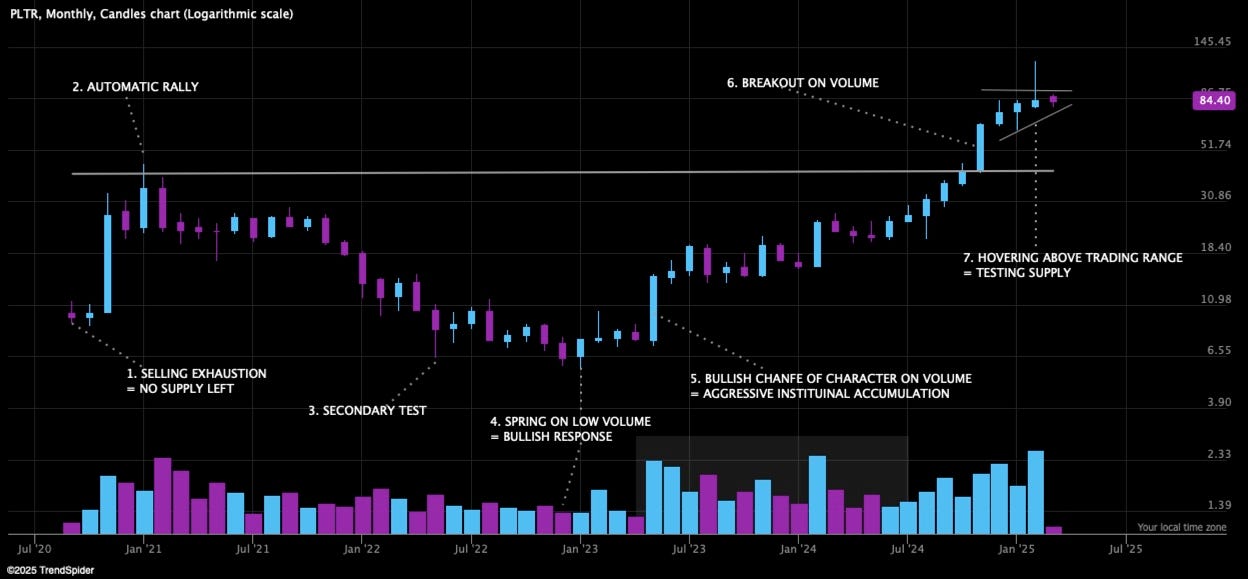How do you catch a stock such as Palantir?
A Deep Dive in the Anatomy of a Stocks Behaviour
Stalking Emerging Leaders
The best stocks are the stocks you just never seem to be able to buy without the feeling that it always runs away from you. This is the hallmark of a superperformer and a leading stock. So how do you catch such a stock? Like Qullamagie said in a podcast “You just buy it”.
He is most certainly right, but you have to buy it at the right time. And you have to study the predictable behaviour of stocks, to give you the confidence to buy stocks after massive moves.
Stocks behavior are highly predictable. In this post I will introduce the concept of the Wyckoff trading range.
The Wyckoff Methodology
All stock candles are a product of supply and demand. What drives supply and demand in big stocks are fund and instituitonal interest. Funds have a longterm perspective. Therefore they accumulate stocks in a smart way.
This leaves a footprint in the charts that you can analyze to see in what phase the stock is. And when it approaches the tipping point = Extreme demand with limited supply = Very bullish price response.
Palantirs chart is a perfect example of this type of price action. Look at the weekly chart while reading this:
1. The Selling Climax
The trading range starts with a selling climax. The point where the price is so low the sellers are exhausted. This should have a higher volume than normal.
Instead of a climax, there can also be a low volume selling exhaustion, like in Palantirs case. Supply is low, nobody wants so sell and demand takes over.
2. The Automatic Rally
When supply is depleted there will always be an automatic rally, because demand is in control. You can call this a relief rally, strong hands accumulated at the lows, making the stock propel significantly higher in a short period of time.
3. The Secondary Test
After a relief rally comes a new test of supply — the secondary test. The stock move close to it’s previous low to test if there is any supply left.
Important supply and demand zones are usually tested several times. The secondary test is usually the point where institutions patiently and systematically start accumulate stocks at the lows of the trading range.
They buy in a way, as to not make the stock price increase rapidly, but always continue accumulating stocks.
4. The Spring
The spring is the most important part of the trading range. The price is tested for supply under the lowest price.
If there supply is present, the stock would just continue falling on high volume, a break down in essence.
In Palantirs case, there was no supply left. No decrease in price below prior low on volume occurs.
5. The Test Of Spring
After institutions have tested the supply, there is usually one last test, the test of spring.
The price approaches the spring level again, and you want to see a higher low and bullish response.
6. The Change Of Character
Now we have a change of character in the stock and institutions start to accumulate stocks more aggressively and impatiently.
This propels the price higher. You can see this clearly in the chart, as a major increase in overall volume on bullish price action.
7. The Breakout
The final stage of the trading range is the breakout on high volume, which is the most common buy point.
After the breakout stocks usually hover above the trading range testing supply again. When you have a followthrough from the breakout you have a new confirmed uptrend.
Weekly and Monthly charts
Charts from TrendSpider
Disclaimer:The Setup Factory is not licensed to give any investment advice. The content provided in this email and from this Substack-account is my own thoughts and ideas about the stock market. It is for educational purposes only and should not be considered as any form of investment advice. Do not invest in any stock based solely on the information provided here. Trading stocks is highly speculative and involves a high degree of risk of loss. You could lose some or all of your money. You should conduct your own research and due diligence in any investment you do, to verify any information provided.






